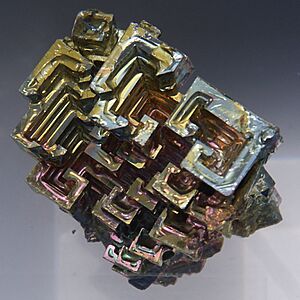Bismuth fluoride facts for kids
Bismuth fluoride isn't just one chemical! It's actually a name for two different chemical compounds that are made from the element bismuth and fluorine. These two compounds have different properties and uses.
Contents
What is Bismuth Fluoride?
Bismuth fluoride refers to two specific compounds: Bismuth(III) fluoride and Bismuth(V) fluoride. Both are combinations of bismuth and fluorine atoms. The numbers (III) and (V) tell us how many electrons the bismuth atom has shared or gained in the compound, which changes how the compound behaves.
Meet Bismuth: The Element
Bismuth is a fascinating chemical element found on the periodic table. It's a shiny, brittle metal that looks a bit like tin or lead. However, unlike lead, bismuth is not toxic. In fact, it's used in some medicines, like those for upset stomachs, and in cosmetics. It's also known for its beautiful, rainbow-colored crystals when it cools down slowly from a melted state.
What are Fluorides?
A fluoride is a chemical compound that contains the element fluorine. Fluorine is a very reactive gas. When fluorine atoms combine with other elements, they form fluorides. You might know about fluoride because it's often added to toothpaste and drinking water to help prevent tooth decay.
The Two Forms of Bismuth Fluoride
The two main types of bismuth fluoride are Bismuth(III) fluoride and Bismuth(V) fluoride. They look different and have different strengths as "oxidizing agents."
Bismuth(III) Fluoride (BiF3)
Bismuth(III) fluoride is a pale yellow solid. It's known as a weak oxidizing agent. An oxidizing agent is a chemical that can take electrons from other substances during a chemical reaction. Think of it like a magnet that can pull tiny electron particles away from other atoms. Because it's a "weak" oxidizing agent, it doesn't pull electrons very strongly. This compound is often used to make other bismuth compounds. It's also studied for its potential uses in materials science, like in some types of glass or ceramics.
Bismuth(V) Fluoride (BiF5)
Bismuth(V) fluoride is a colorless solid. Unlike its cousin, it's a very powerful oxidizing agent. This means it's extremely good at taking electrons from other substances, making it highly reactive. Because it's so reactive, it needs to be handled very carefully in laboratories. Scientists use Bismuth(V) fluoride in special chemical reactions, especially when they need to add fluorine atoms to other compounds. It's a strong "fluorinating agent," which means it's excellent at introducing fluorine into other molecules.
Why Are Bismuth Fluorides Important?
Bismuth fluorides, especially Bismuth(V) fluoride, are important tools for chemists. They allow scientists to create new compounds and study how different chemicals react. While you might not see them in everyday products, they play a role in advanced chemical research and the development of new materials. Their unique properties as oxidizing agents make them valuable in specialized chemical processes.


